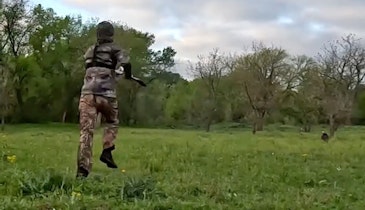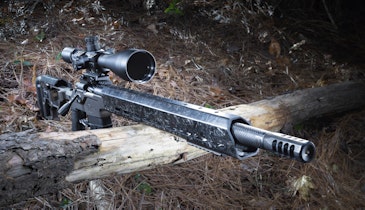We all know the familiar phrase “ace in the hole.”
Formally defined as a hidden advantage or resource kept in reserve until needed, the origins of the saying harken back to Wild West games of stud poker, where one face-down card in front of a player (especially the potential of an “ace” sitting there “in the hole”) can change the entire complexion of a hand.
So what does it all have to do with whitetail hunting? Like a game of poker, hunting the rut can be a real crapshoot. You must play the cards you’re dealt, but you also have to compete with factors conspiring against you. If those forces start gaining the upper hand, it’s nice to know you have your own ace in the hole to lean back on.
Rut Challenges
Every whitetail hunter loves the rut. Whether it happens in gun or bow season (or both) where you hunt, this is supposedly the time of year when bucks lose all sense of caution, run wild, patrol large swaths of countryside at any and every time of day, chase does with reckless abandon, and generally make the kinds of survival mistakes that result in antlers on your wall and venison in your freezer.
Occasionally, the rut does happen that way. But reality is often different. Much can go wrong to mess up your carefully laid rut-hunting plans.
Weather can be bad for days on end. Whether it’s wind, rain, sleet, snow or all of the above, bad conditions make whitetails hunker down while their keen senses of smell and hearing are so compromised. A sunny stretch of late-fall warmth can also put a damper on deer activity simply because whitetails encased in their thick winter coats — even bucks with sex on their minds — are loathe to move and overheat under such mild conditions.
Timing can really get mixed up. Every year is different, and even though photoperiod drives rutting activity, specific longer-term weather patterns can throw whitetails off typical rutting activities and times. Just because bucks were actively seeking does the first week of November during daylight hours last year in your area doesn’t mean it’s going to happen the same week this year.
Movement patterns you carefully monitored all fall just fall apart. In most places, crop harvests are finishing up and food sources are changing as the rut kicks in, and whitetail does (which really drive rutting activity anyway by their receptiveness or lack thereof to bucks) are changing their daily habits and circuits.
The bucks are tending does closely. When you reach those advanced stages of the rut when the does are coming into estrus and are receptive to breeding, the bucks know it and hang close to the objects of their desire. It can seem like there’s not a deer in the township at these times. If the does slide into cover and try bed for the day, that’s where the bucks are going to be.
Traditional Rut Approaches
When I first started hunting whitetails back in the late 1960s, we didn’t even know what a scrape was. Sure, while bowhunting we found these pawed-out spots along wood’s edges, and even began to put two and two together when we saw bucks visit these areas, freshen them up, rub their eyes on surrounding branches, and even chew on a twig or two.
Then came the 1970s and a relative explosion of information about hunting rutting bucks. Hunting scrapes became all the rage, with rub lines not far behind in popularity. The focus was on these signposts as supposed circuits that bucks would regularly travel.
In the ensuing decades, as whitetail became more studied and better understood, conventional rut hunting wisdom began to change. Yes, scrapes, rubs and other evidence of bucks in the neighborhood were all important, but travel funnels turned into the rut-hunting hotspots, and for good reason — bucks follow does, but does are still trying to maintain a low-key lifestyle in the places they always frequent.
So what do you do when the whitetails aren’t out and moving like they’re supposed to be? What happens when one of those rut challenges hits? The solution is to go all-in and hunt the bedroom.
Why Hunt The Bedroom?
This answer might surprise you. In fact, it probably even goes against some of the conventional whitetail hunting lore you’ve absorbed through the years. But the best hunters get aggressive and take chances when the pursuit gets tough. For that reason, my advice goes against the grain, but here it is: Hunt bedding areas, escape cover, safe zones, secluded hideouts under cover — anywhere whitetails like to spend their days. The reasons are two-fold.
First, you have to hunt where the does are. If the rut is going bad, changing your approach is essential. When deer just aren’t moving, you have to go find them. Think about where you would go to kill a doe — then go there to kill the buck that’s most certainly following her. A “bad” rut for you and me is often the result of good conditions for the bucks — so many does that they don’t have to go searching for more. So hunt the does to find the bucks. Where’s the best place to do that? A bedroom area.
Secondly, remember that whitetails stay active all day here. Even at the peak of the rut, whitetails usually just don’t go gallivanting willy-nilly around open country all day long. The field edges and travel funnels that you’re hunting might not be seeing any traffic because the bucks are holed up with hot does. So that’s where you need to be — under cover and in the timber or brush, where whitetails will get up and move at any time of day.
Bedroom Hunting Techniques
Here are eight key things to remember when hunting an off-the-beaten-path whitetail hole.
1) Pack in a portable. The key to successfully hunting a bedding area is keeping the wind in your favor. You’re already hunting aggressively (and smartly so) by entering a whitetail safe zone. Playing the wind right is essential. Use a portable stand and hang it each day according to prevailing breeze conditions. If the airflow shifts, shinny down and rehang. Just make sure you do so as quietly and unobtrusively as possible.
2) Hang a couple of stands. If you know the local whitetail bedrooms well, get in and hang a couple of bedding-area stands well before the rut, then leave them alone until you need them. With a couple of stands, you have a better chance of being ready for different winds. And there is an advantage to the stealth that pre-hung stands offer you for getting in and out silently.
3) Get in early, stay all day. Get into a bedroom zone early, while the whitetails are out in the fields or off at feeding zones. Take a backdoor route — loop around as far as you need to — to get into that bedroom without disturbing whitetails in their night places. Carry in clothes for the long haul, pack lunch, stay put, and expect midday action as bucks patrol the area, court does or follow them through.
4) Anticipate quick action. Especially if the bucks are tending does, action can happen abruptly in a whitetail bedroom. Don’t hang your bow or set your firearm down, but keep it in hand. Often bucks will appear seemingly out of nowhere, or maybe an in-cover chase will come your way, and fast. If action passes by out of range, don’t sit back and think you’re done. Stay put and be even more vigilant. You’re right where the whitetails want to be. They’ll return; maybe in a minute, maybe an hour.
5) Hunt low-key. You’ve made an aggressive move just by hunting a whitetail bedding zone. Don’t call attention to yourself with overly aggressive tactics.
6) Leave decoys at home. They’re more for open areas anyway, plus it takes some rigmarole and time, not to mention spreading your scent, to set up a fake.
7) Be careful with rattling. If you can’t leave the rattling antlers at home, avoid mimicking an all-out buck fight. Instead, a few occasional tickles might work, but that’s it.
8) Grunt sparingly. Carry a grunt call, but use it only softly and sparingly; the one exception here is a loud grunt to stop a moving buck for a standing shot.
Conclusion
The whitetail rut is a fickle event that can deal you some challenging cards. Sometimes, when you think deer should be running everywhere, whitetail country seems empty. Then it’s time to use that ace in the hole you’ve been holding and head to a bedding area for a low-key, all-day sit.






